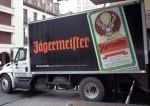
You’ve probably noticed that the various alcohol distribution trucks you see on the road do not display placards for flammable liquids as you might expect; why? The answer is the exception to the Hazardous Materials Regulations of the USDOT/PHMSA for the transportation in commerce of alcoholic beverages found at 49 CFR 173.150(d).
49 CFR 173.150(d) reads:
Alcoholic beverages. (1) An alcoholic beverage (wine and distilled spirits as defined in 27 CFR 4.10 and 5.11), when transported via motor vehicle, vessel, or rail, is not subject to the requirements of this subchapter if the alcoholic beverage:
(i) Contains 24 percent or less alcohol by volume;
(ii) Is contained in an inner packaging of 5 L (1.3 gallons) or less; or
(iii) Is a Packing Group III alcoholic beverage contained in a packaging 250 liters (66 gallons) or less;
(2) An alcoholic beverage (wine and distilled spirits as defined in 27 CFR 4.10 and 5.11), when transported via aircraft, is not subject to the requirements of this subchapter if the alcoholic beverage:
(i) Contains 24 percent or less alcohol by volume;
(ii) For transportation aboard a passenger-carrying aircraft, contains more than 24% but not more than 70% alcohol by volume when in unopened retail packagings not exceeding 5 liters (1.3 gallons) carried in carry-on or checked baggage, with a total net quantity per person of 5 liters (1.3) gallons (See §175.10(a)(4) of this subchapter); or
(iii) When carried as cargo, contains more than 24% but not more than 70% alcohol by volume in an inner packaging not exceeding 5 L (1.3 gallons).
So, we must first determine if our HazMat meets the definition of an alcoholic beverage for the purposes of this exception. An alcoholic beverage must be one of the following two:
Or…
- Distilled spirits as defined at 27 CFR 5.11.
Definitions for both are included at the end of this article.
Like this article? Subscribe to my Monthly Newsletter No marketing emails! |
So, if it is an alcoholic beverage, it is not subject to the HMR (shipping papers, placards, labels, markings, specification packaging, etc.) if it…
- Contains ≤24% alcohol by volume.
Or…
- Is in an inner packaging of 5L (1.3 gallons) or less.
Or…
- Is a Packing Group III alcoholic beverage in a packaging of ≤250L (66 gallons).
Two USDOT/PHMSA interpretations confirm that this exception may be used for alcoholic beverages that meet any one of the above three conditions: §173.150(d)(1)(i), (ii), or (iii). (10-0014, 09-0140) Though both of the letters of interpretation are answering question about shipping alcoholic beverages by air, they still make reference to the three conditions of §173.150(d)(1).
Note a subtle but important distinction in the packaging type of these conditions. §173.150(d)(1)(ii) refers to an “inner packaging” whereas §173.150(d)(1)(iii) refers simply to a “packaging”. The use of the term inner packaging refers to a container that will be placed into outer packaging forming what’s known as combination packaging for its transportation. An example of this would be a 1 gallon jug of wine (inner packaging) packed into a wooden crate (outer packaging or just “packaging”) for shipment . §173.150(d)(1)(ii) doesn’t limit the volume of the outer packaging, so it could be much more than 66 gallons.
The condition of §173.150(d)(1)(iii) does not set a limit on the alcohol content or the volume of the inner packaging but it does limit its use to a Packing Group III Flammable Liquid, the least dangerous of the flammable liquids, and limits the volume of the entire packaging to no more than 66 gallons.
The transportation of an alcoholic beverage by air (either passenger or cargo) may be subject to an exception found at 173.150(d)(2). That article will have to wait until a later day, however. If you’re interested just ask me and I’ll look into it.
If your HazMat is not an alcoholic beverage designed for consumption, there may still be an exception available for its transportation if it meets the definition of an aqueous solution of alcohol. Read this article for an exception available for the transportation of aqueous solutions of alcohol.
Definitions:
Wine. (1) Wine as defined in section 610 and section 617 of the Revenue Act of 1918 (26 U.S.C. 5381-5392), only if for nonindustrial use and containing not less than 7 percent and not more than 24 percent of alcohol by volume; and
(2) Other alcoholic beverages not so defined, but made in the manner of wine, including sparkling and carbonated wine, wine made from condensed grape must, wine made from other agricultural products than the juice of sound, ripe grapes, imitation wine, compounds sold as wine, vermouth, cider, perry, and sake, only if for nonindustrial use and containing not less than 7 percent and not more than 24 percent of alcohol by volume.
Distilled spirits. Ethyl alcohol, hydrated oxide of ethyl, spirits of wine, whisky, rum, brandy, gin, and other distilled spirits, including all dilutions and mixtures thereof, for nonindustrial use. The term “distilled spirits” shall not include mixtures containing wine, bottled at 48 degrees of proof or less, if the mixture contains more than 50 percent wine on a proof gallon basis.
Note that while wine has a defined alcohol content (≥7% and ≤24%) distilled spirits do not. Both, however, are meant for “nonindustrial use”.
Daniels Training Services 815.821.1550 |
You may not have anything to do with the shipment of alcoholic beverages, but this article illustrates the fact that hazardous materials, the HMR, and exceptions to the HMR surround us everyday. Many materials we regard as common: fuel, wine, batteries, cleaners, and more, are all hazardous materials regulated in some way by the USDOT/PHMSA when transported in commerce. This includes the hazardous materials, including hazardous waste, received at or shipped from your facility. Contact me for a free consultation of your training needs.

